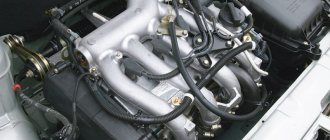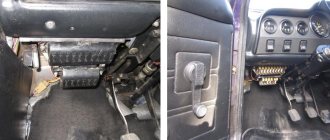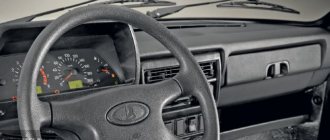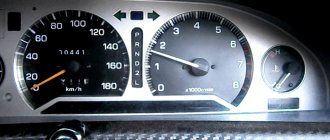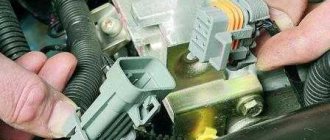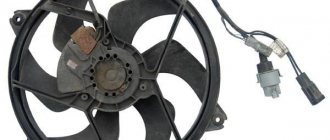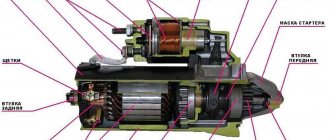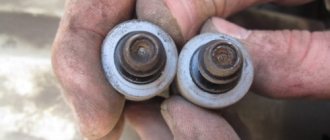When a car engine is running, its fuel system is constantly at risk of contaminants depositing on its elements (injectors, fuel lines, pressure regulator, intake valves, fuel rail). All these dangers are primarily contained in the fuel; of course, the quality of the fuel has improved recently, but it is still far from being comparable to foreign analogues. By the way, good fuel contains additives that do not allow contaminants to accumulate in the fuel system and clean the engine combustion chamber.
Fuel injector - what is it?
The injector is an important mechanism of the fuel system and is intended for timely and dosed supply of fuel into the combustion chamber of the internal combustion engine.
It is a mechanical fuel sprayer into the engine cylinders. Its main feature is to ensure precise dosage of fuel injection at a certain time point.
In the modern automotive industry, these parts are used on both gasoline and diesel engines, since they provide fuel supply in strictly limited portions and at a given point in time.
The development of this fuel supply system in automobiles began in the 60s. Currently, there are three types of injectors depending on the injection method:
- The electrohydraulic version is used in engines running on diesel fuel, as well as in engines with a Common Rail fuel system . It has a more complex device, structurally consisting of a control chamber, a valve, an inlet throttle and a drain channel. Its operation is based on the use of the already existing high pressure of the fuel mixture in the system. At the initial stage, the valve is closed and the needle is pressed as much as possible against its seat in the control chamber. Then the valve opens and fuel enters the injector through the drain throttle. It flows from the control chamber into the drain line. At this time, the intake throttle prevents the rapid equalization of pressure in the combustion chamber and in the intake manifold. In this case, as the pressure on the piston decreases, its clamping force weakens, and since the pressure on the needle does not change, it rises, and at this moment fuel is injected. A description of the operating principle of this type gives an understanding of why a diesel injector leaks.
- An electromagnetic injector is usually installed in gasoline engines . They have a simple device consisting of a solenoid-type valve, a nozzle and a spray needle. The operating principle of this type of part is also simple. Voltage is supplied to the injector winding strictly at the set time, in accordance with the programmed program. The voltage creates a certain electromagnetic field, which pulls the weight with the needle out of the valve, thereby opening the nozzle to inject the required amount of fuel. After which the voltage decreases, the needle returns to its original position and the nozzle closes. A description of the operating principle of this type gives an understanding of why injectors on a gasoline engine leak.
- The piezoelectric variety is by far the most advanced and promising among the three listed devices for injecting fuel into engine cylinders . Its scope of application is diesel internal combustion engines with a Common Rail fuel supply system. Structurally, it consists of a pusher, a special piezoelectric element, and a needle. It works on the principle of a hydraulic mechanism. Initially, the needle is placed in the valve seat due to the high pressure of the vehicle acting on it. After an electrical signal is applied to the piezoelement, its length increases and it literally pushes the pusher piston, which in turn pushes the switch valve piston. This leads to the opening of the switching valve, through which fuel flows into the drain line, the pressure in the upper part of the needle decreases and, due to the unchanged pressure from below, the needle rises. When the needle rises, fuel is injected.
Fuel injectors have a number of advantages over carburetors:
- saving fuel consumption thanks to an accurate dosing system;
- minimum level of exhaust toxicity;
- possibility of increasing motor power up to 10%;
- simplicity and ease of starting in any weather;
- no need for frequent replacement and cleaning.
All these advantages allow you to reduce the cost of operating and maintaining your vehicle. This part is very demanding on the quality of fuel and engine oil, as a result of which it often leaks.
The main causes of injector contamination.
But the injectors of cars that are operated in the territory of the former USSR have to be cleaned every 15 - 30 thousand kilometers. There is only one reason for the poor quality of fuel - the desire to receive excess profits from the sale of fuel and lubricants. As a result:
- Insufficient capacity for the production of A-92 and A-95 gasoline, but A-98 at domestic gas stations is in most cases a myth and a cunning marketing ploy - nothing more;
- Violation of fuel storage conditions. Often, the same tanks are used to store gasoline A-76, A-80, A-92, A-95, A-98, in which various tar deposits accumulate over the years of operation, dissolved by fuel with a higher octane number. As a result, tar deposits are washed into the tanks of our cars, leading to failure of the fuel system;
- The use of manganese-containing additives in the production of fuel, which increase anti-knock resistance. These are so-called anti-knock agents, which allow you to turn low-octane gasoline into high-octane gasoline with a slight movement of the hand. For example, an A-80 can “by magic” become an A-95, and there will be no detonation and its consequences as such. The additives, in turn, cause increased wear of the spark plugs and accelerated contamination of the fuel filter with fine brick-colored particles.
All these reasons lead to the need to replace spark plugs, clean the injector, and in some cases even overhaul the engine.
How to check an injector nozzle for serviceability
How to check the serviceability of an injector nozzle
Problems with injectors occur both on cars powered by diesel fuel and on gasoline injection cars. An injector is a part responsible for injecting fuel under a certain pressure. It is useful to know how to check the injector nozzle if starting difficulties occur.
Causes and symptoms
Accurate metering of fuel, tightness of hoses and seals, activation of the injector at the right moment are prerequisites for stable and trouble-free operation of the engine. If the injection part leaks, as they say, then the efficiency of fuel atomization deteriorates, i.e., the shape of the flame is upset and the power unit smokes, either black or gray, it is difficult to start, consumption increases, and power is lost.
“The injector is leaking” is an expression that means fuel is leaking at a time when it is not needed.
There are many culprits for poor performance. For example, a dirty filter, a non-working fuel pump or bad spark plugs. The same thing happens due to the fault of a failed reel or due to problems with the timing belt.
If it is pouring, the injector is leaking
The most important symptom of a non-working injector is difficulty starting the internal combustion engine. This is especially true for a “cold” engine. In addition, as mentioned above, symptoms include increased fuel consumption and unstable engine operation in idle mode. The last symptom generally resembles almost a tripping of the engine, as if one of the cylinders is not working.
As for the driving signs of a non-working injector.
- The car moves jerkily, especially when trying to accelerate. The accelerator pedal is dull.
- Jerking while driving, after changing gears or releasing the gas pedal.
- There is an undisguised fiasco in traction and aphasia of dynamics during acceleration or maneuver.
Defects in injection elements should be corrected immediately, otherwise it will negatively affect the service life of the engine and gearbox. Experts also do not recommend driving with a faulty injector, because it is simply dangerous. On steep climbs, when maneuvering and overtaking, a car with a failed injector can play a cruel joke on the driver.
How is diagnostics carried out?
You should know that car injectors are classified into several types. Today, two of them are in use: conventional and electric injection elements (magnetic).
Electric or, more correctly, electromagnetic injectors (EMF) are equipped with a special valve that supplies fuel. It, the valve, is controlled by the power unit ECU using sent pulses.
As for mechanical injectors, they open as the gasoline pressure in the injector increases, i.e., automatically.
On modern cars, the first variants of injectors are often installed - EMF.
Checking the injector itself without removing it
Injector testing can be done in several ways. However, in use
Checking the injector
the simplest of them, and this is not surprising. It makes it possible to quickly test the injectors without even removing them from the car. The fundamental factor in such diagnostics is the analysis of the noise emitted by the motor during operation.
If a muffled high-frequency noise is heard from under the hood, this indicates the importance of cleaning the injectors or a problem with one of them.
Checking power supply
It is recommended to check how the power is going. This test option is carried out only when the injectors themselves are functioning flawlessly, but difficulties are observed with starting.
Here's how this kind of diagnosis is carried out:
- the block is disconnected from the injection system;
- two wires are connected to the battery, which are simultaneously connected at the other ends to the injectors;
- Now you need to start the engine and check the presence or absence of gasoline leakage.
According to the result, the following conclusions are drawn:
- if fuel leaks, it means there is a problem in the car’s electrical circuit;
- if not, then everything is fine.
Another test option involves using an ohmmeter. This method allows you to measure the resistance on the injectors, and draw conclusions accordingly.
This is done as follows.
- You need to find out the standard parameter of the injection elements of a particular car (for example, for a VAZ - 11-15 Ohms). Some foreign cars are of greater or lesser importance.
- Next, you need to disconnect the terminal from the battery, thereby de-energizing the system.
- Remove the electrical connector from the injector using a screwdriver with a thin pin. It will be enough to snap off the special clamp installed on the block.
- After this, connect the terminals of the device to the injection parts to measure the indicator.
In this way, you can measure the compliance of the resistance indicator with the required one. If deviations from the norms are noticeable, the faulty injector is removed from the vehicle and replaced with a known good one. After this, you can check the resistance again, and be sure to evaluate the operation of the motor. If everything was done correctly, the engine characteristics should change.
Analysis of the operation of injectors on the ramp
This method already involves dismantling the fuel rail. The injectors, of course, are removed along with the ramp. Then reconnect all electrical contacts to the ramp (after all, they are thrown off during dismantling). The negative terminal of the battery, which was removed earlier, also returns to its place.
Further:
- the ramp is placed in the engine compartment so that it is possible to place a container with a printed scale under the injectors;
- the fuel supply hoses are connected to the ramp (be sure to securely fix them at the ends);
- the engine is started by the starter (it is advisable to work together with an assistant);
- while the assistant rotates the starter, you need to test the operating efficiency of all injectors (gasoline must be supplied equally to all injectors);
- at the last stage of the procedure, the ignition is turned off, the level of gasoline in the containers is checked (obviously, the level should be the same).
Anyone can check the injector nozzle with their own hands. It is not necessary to go straight to a car service center if you encounter another problem. An experienced motorist should be able to do some repairs himself.
Didn't find the information you are looking for? on our
forum
.
If you find an error, please select a piece of text and press Ctrl+Enter.
Troubleshooting
Despite their undeniable advantages over carburetor systems, injection engines are quite capricious, subject to the influence of many factors and have higher maintenance requirements.
Engine performance depends on the condition of the injectors. The main external signs of problems with injectors are:
- jerks and dips when accelerating the car;
- reduced engine speed;
- unstable operation at idle and low speeds;
- high content of toxic substances in the exhaust.
Checking with a stethoscope
You can carry out diagnostics yourself or contact a car service. The procedure for checking injectors with your own hands is as follows.
- Check the valve. If it does not move, then either the injector itself or the electrical circuit is faulty.
- If a characteristic sound is heard when the valve opens, it is working properly. If there is no sound, the valve is not working.
When diagnosing injectors, you can use a stethoscope.
- Using a stethoscope, listen to the injectors click when idling. Listen in such a way that the clicks are not transmitted along the fuel rail to the non-working injector from the working one.
- Make sure that the frequency of clicking sounds increases as engine speed increases. Otherwise the injector is faulty.
Video: checking injectors with a stethoscope
Checking with a multimeter
A multimeter is a special device for diagnosing electrical circuits.
- In the technical documentation, find the resistance value of the injectors installed on your car.
- Disconnect the wires from the injectors.
- Set the multimeter to resistance measurement mode.
- Connect the multimeter contacts to the injectors.
- Measure the injector resistance.
The normal impedance of injectors with low resistance should be 2–5 Ohms, with high ones – 12–17 Ohms. If the values do not match, the injector is replaced with a new one.
Testing at the stand
The stand can have a different design, it can be expensive or cheap. Simple stands can be found in private garages. They are used to check the pressure of the injectors. Professional stands allow you to most accurately diagnose and adjust injectors. Such equipment is usually available only in service centers.
Professional injector testing stand
As a simple stand for checking injectors, you can use the MTA-2 mechanical tester. With its help, you can easily check the condition of the injectors, pressure, fuel injection pump. There is no need to disassemble the engine.
The Bosch stand is more expensive and complex. Many experts call it the standard of quality for diagnosing injection pump. The stands “Delphi”, “Hartridge”, “Rabotti” and others also show good results.
Video: adjusting the nozzle on the stand
What is a nozzle
An injector is an integral part of the engine fuel system that supplies fuel to the cylinders at a certain time in a certain quantity. Fuel injectors are used in diesel, injection, and mono-injection power units. Today, there are several types of nozzles that are fundamentally different from each other.
Self-check of injectors
Let's start with the fact that automobile injectors are divided into several types, of which two types have found widespread use at different times: mechanical injectors and electromagnetic (electromechanical) injectors.
Electromagnetic injectors are based on a special valve that opens and closes the injector to supply fuel under the influence of a control pulse from the engine ECU. Mechanical injectors open as a result of increased fuel pressure in the injector. Let us add that modern cars often have electromagnetic devices installed.
To check the injectors with your own hands without removing them from the car, you can use several methods. The simplest and most affordable way to quickly check injection nozzles without removing them from the car is to analyze the noise emitted by the engine during operation.
—>Auto parts and service stations —>
A modern diesel engine is a high-precision fuel supply and injection system. However, modern diesel is not the most reliable unit. In many ways, the reliability of a diesel engine is not related to the design of the system itself, but rather depends more on the quality of the fuel used in the vehicle. And since in the countries of the former USSR diesel fuel is not of the best quality, breakdowns often occur in the diesel system. Due to low-quality fuel, owners of diesel cars most often have to contact a service station to repair injectors. Unlike gasoline injectors, which are most often completely replaced and not repaired, diesel injectors can be repaired. In order to understand whether injector repair is necessary, let’s try to understand a little theory.
Signs of a faulty diesel engine injector
Most often, a malfunction of diesel injectors is detected very quickly by the driver. But if the owner of a diesel car has no experience of owning such a car, then he may not immediately recognize the breakdown. The first thing you should pay attention to is the operation of the engine. At the first stages, no signs of breakdown appear. On the contrary, the car starts to drive a little better than usual. Yes, I didn’t make a mistake now. Everything is exactly like that. The fact is that due to faulty injectors, more fuel than required may enter the combustion chamber. Because of the rich mixture, the car starts to drive better.
If you miss this moment, then a smooth ride will gradually develop into a larger breakdown. After some time, you will begin to notice that the car began to smoke when starting, and the idle speed became unstable, and the speed began to fluctuate.
At the most advanced stages, fuel consumption increases significantly, and the car begins to smoke even when driving or sharply pressing the gas pedal. Gradually, as the injector pours fuel, it will begin to flow through the rings into the oil. This may cause the engine oil level to increase and its properties to deteriorate. And this can already lead to serious repairs.
Which indicates possible problems with the injector
Let us immediately note that there can be many reasons for unstable engine operation, ranging from a clogged fuel filter, a broken fuel pump, a failed spark plug or a faulty coil, to loss of compression, problems with the timing belt, etc. Along with this, one of the main signs of injector malfunction is difficulty starting the engine, especially when cold, as well as gasoline or diesel consumption (depending on the engine type), which increases noticeably. It is also necessary to note the unstable operation of the internal combustion engine in idle mode, similar to the so-called “triple” of the engine.
When driving, it is possible that one or several symptoms may occur quite frequently:
- presence of jerks, very slow reactions when pressing the gas pedal;
- obvious failures and loss of dynamics when trying to accelerate sharply;
- the car may jerk while driving, when releasing the gas, and also after changing the load mode on the engine;
It must be added that such a malfunction must be corrected immediately, since problems with the injector negatively affect not only the service life of the engine and transmission, but also overall traffic safety. In a vehicle with faulty injectors, the driver may experience serious difficulties when overtaking, on steep hills, etc.
Location and principle of operation
Depending on the type of fuel system, the injector can be located in several places, namely:
- Central injection is a mono-injector, meaning that the fuel system uses only one injector mounted on the intake manifold, just ahead of the throttle valve. It is an intermediate link between a carburetor and a full-fledged injector;
- distributed injection - injector. The nozzle is installed in the intake manifold and mixes with air entering the cylinder. It is noted for its stable operation, due to the fact that the fuel washes the inlet valve, it is less susceptible to carbon deposits;
- direct injection - the injectors are mounted directly into the cylinder head. Previously, the system was used only on diesel engines, but by the 90s of the last century, auto engineers began testing direct injection on an injector using a high-pressure fuel pump (high pressure fuel pump), which resulted in increased power and efficiency compared to distributed injection. Today, direct injection is widely used, especially on turbocharged engines.
Basic faults
The most common injector malfunctions are as follows.
Injector knock
One of the most common malfunctions is injector knocking. The injector is constantly under load and becomes dirty - this is the source of sounds similar to high-frequency knocking (chirping).
The consequences of the appearance of such sounds are as follows.
- reduction in engine power;
- dips when pressing the accelerator pedal;
- floating idle speed;
- increased content of toxic substances in exhaust gases.
This problem can be corrected by washing or replacing the injectors.
Fuel leakage through injectors
This malfunction, typical of diesel engines, most often occurs due to wear of the injector washer. Less commonly, the cause of the leak is the connection between the fuel pipes and the injector.
The procedure for identifying and eliminating the source of a leak is as follows:
- The nozzles and their connections with the tubes are wiped dry.
- Areas of possible leakage are treated with ordinary chalk.
- The starter cranks for 3–4 seconds without starting the engine.
- Leak points will be clearly visible on white chalk.
- If the housing leaks, the nozzle is replaced with a new one.
- If a leak is found in the area between the head and the injector, the copper O-ring is replaced.
If the housing allows fuel to pass through, the injector is replaced with a new one.
No fuel supply
If there is no fuel flowing into the injectors, the cause should first be sought in the high pressure fuel pump. The injection pump belt should be checked for breakage or sagging.
Then you need to remove one of the hoses coming from the injection pump, place its end in a container and turn the starter. If fuel does not flow, the pump is faulty.
Sometimes fuel may not flow into the pump itself. In this case, the hose at the inlet to the injection pump is removed and checked in the same way. If fuel does not flow, the problem should be looked for in the gas tank pump.
Other faults
Among other malfunctions, it is worth highlighting the following.
- The intermediate washer located between the spring and the nozzle wears out and becomes bent. The needle does not rise high enough, and the fuel flows unstably.
- The spring wears out and loses its rigidity. The spring is changed, or several additional washers are installed in the nozzle.
- Damage to the nozzle body itself.
Why is the injector leaking?
Why does the nozzle on an injection machine leak? Because the o-rings have deteriorated. Let's talk about this in more detail.
Rubber O-rings are used to eliminate air leaks and fuel leakage at the point where the injector is connected to the fuel line, in other words, for sealing. They can have an x-shaped, round or rectangular cross-section. They can be elastic, rigid, resistant to temperature changes, the negative effects of aggressive environments and various chemicals.
1. Seals on different types of injectors.
Self-ignition of the working mixture occurs due to the high degree of compression; the load on the cylinder-piston group is high. A common mechanical pump injector is screwed into the cylinder head; to ensure a tight seal, a soft metal washer is used, installed on the bottom of the landing well. Copper is most often used, less often aluminum alloys. The metal must be soft and deform when tightened to ensure a tight seal.
Injection is carried out through a mechanical drive from the camshaft through pushers with rocker arms. Fuel is supplied through a metal pipeline; the return drain line is sealed with copper washers on the fittings.
Modern interpretations of this part are controlled electronically, which makes it necessary to significantly increase the fuel inlet pressure. This led to the need to use additional seals.
Inlet or upper o-rings are found on both gasoline and diesel injectors. They serve to eliminate air leaks and fuel leakage at the point where the injector is connected to the fuel line. They are most often made of rubber, since there are no large mechanical and temperature effects. However, the requirements for the material of the rings are high in terms of elasticity and its preservation under the influence of aggressive environmental factors.
The lower seal operates under more severe conditions, so the following options are possible:
- one metal ring;
- one rubber, made of a special composition, capable of withstanding temperature and mechanical stress;
- metallic and elastic at the same time;
- no one.
2. Symptoms of faulty o-rings.
It is often quite difficult to determine what caused the damage and failure of the o-ring - errors in design, improper installation or non-compliance with operating conditions. Sometimes a malfunction can be caused by several factors acting simultaneously. As a rule, damage to the upper seal is detected by fuel leaks. It could just be a wet spot, drops or even a trickle. Leakage of fuel here is very dangerous due to the possibility of it flowing down onto the hot output manifold, which definitely leads to a fire; urgent replacement is required.
If the lower seal is faulty, air leaks in and the mixture becomes lean. The engine starts only when the gas pedal is partially pressed, idles unstably, and power decreases, especially at low speeds.
With high mileage, the rings, especially the lower ones, due to high temperatures, can simply become stiff and lose elasticity. Then the smell of gasoline appears in the cabin at low temperatures when starting. The replacement may wait a little, but you shouldn’t delay it for too long.
On some diesel engines, leaks in the lower o-rings lead to gases breaking through and entering the oil. Coke is formed, which is washed into the oil pan and clogs the oil receiver. The main symptom in this case is white acrid smoke within a few seconds after starting, and when the malfunction occurs, the oil pressure lamp blinks. This car cannot be used; faulty parts need to be replaced.
3. When to change the seals on the injectors.
During operation, visible mechanical damage appears on the rubber sealing ring of the nozzle - cracks of various sizes, loss of elasticity and other deformations. Loss of tightness can lead to serious consequences - fuel begins to leak, and this can cause a fire in the engine compartment of the car, so you should hurry up with replacing the O-rings.
When installing injectors with new sealing rings, be sure to clean the seat, remove all old rings, and clean off any remaining rubber. Place the rings on the injector by hand without using tools, lubricate the new seals with engine oil so that the seal rotates easily in the seat groove.
4. Purchase of seal rings.
If an injector leaks, sooner or later you will need to buy a new one. Along with it, the kit may also include additional elements in the form of a mesh filter, a set of necessary sealing rings, rubber mounting bushings, and plastic plugs.
Rings may be sold in auto parts stores:
- piece by piece;
- set for one nozzle (lower and upper);
- kit for the engine (the number of cylinders is taken into account).
The color of rubber O-rings can be any color and has nothing to do with size or quality.
Bosch injectors of various modifications are used on domestic and imported cars. Since the 90s, they have been unified and are better able to be repaired and restored than other similar ones when they begin to leak.
5. Step-by-step instructions for replacing O-rings on injectors.
To ensure a good seal, O-rings should be placed with slight tension, which increases the strength of the fastening. They should be replaced according to the following instructions.
- Relieve pressure in the fuel system.
- De-energize the machine's electrical components by disconnecting the battery terminal.
- Disconnect all pipes and hoses connected to the fuel rail to gain full access to the damaged element.
- Then, using a hexagon, remove the fasteners, and then remove the ramp with the injectors.
- Remove any old rings using a flathead screwdriver or knife.
- Lubricate the new O-rings with engine oil.
- Finally, return the ramp to its place. It is important to ensure that the seals are not distorted when installing it. Also, do not use excessive force to avoid damaging the elastic.
How to clean the injectors yourself without removing them from the engine
During the diagnostic process, a common cause of unstable engine operation is that the injection nozzles are clogged. There are several ways to clean injectors, among which mechanical, ultrasonic or cleaning using special chemical compounds can be used.
We recommend reading the article about what methods exist for diagnosing and cleaning injection nozzles. From this article you will learn about mechanical, chemical and ultrasonic cleaning of an injector using the example of cleaning diesel engine injectors.
In some cases, pouring a special injector cleaner additive into the fuel tank is enough to normalize the operation of the entire system. It is also recommended to rev the engine to high speeds at certain intervals and accelerate the car to 110-130 km/h. on flat sections of the path. In this mode you need to drive 10-20 kilometers. Continuous operation of the injectors under load allows for so-called self-cleaning.
Finally, we would like to add that the cleaning methods listed above can only remove minor contaminants. A seriously clogged injector must be cleaned mechanically, using pressure compounds or ultrasound. As for washing the injectors, experts recommend washing the injector every 30-40 thousand kilometers traveled.
Cleaning the injector should be done as a preventive measure, and not after signs of malfunction appear. If the car is operated in city driving mode on fuel of questionable quality, then the interval of preventive measures should be reduced in relation to individual operating conditions.
Gasoline additives for injector flushing
Additives for flushing the injector are the cheapest and easiest way to clean it from contaminants. Such additives are available in the range of many auto chemical manufacturers. They are most effective when added regularly to the gas tank.
When the first signs of injector contamination appear, you can apply a shock dose of such additives, but provided that the gas tank and pipelines are relatively clean. Otherwise, all the dirt will end up in the electric fuel pump and fine fuel filter, which obviously will not add durability to these components.
Flushing the injector without removing the injectors from the engine
Cleaning and washing the injector without removing the injectors from the engine is carried out using a simple washing unit:
- to do this, the engine is disconnected from the standard power system;
- instead, a unit for washing the injector is connected;
- after which the motor is forced to run for 20-30 minutes using a special solvent.
The washing ability of this composition is very high and it easily washes away all deposits (for an example, see the video at the end of the article).
Washing and cleaning the injector with ultrasound
Ultrasonic injector cleaning is by far the most effective cleaning method. To do this, the injectors are removed from the engine and placed in an ultrasonic unit with a special solvent.
The operating principle of the installation is as follows:
- In order to help the solvent wash out toxins, it is forced to vibrate using ultrasound.
- Liquid vibrations have virtually no effect on the nozzle, but cause slags to resonate, which peel off from the metal and become easy prey for the solvent.
The time for such injector flushing usually ranges from half an hour to an hour. The advantages of this method include the uselessness of an expensive solvent, however, a fairly large amount of work is required to remove and reinstall the injectors on the engine.
Conclusion
Testing with an indicator screwdriver will help you quickly find a problem when the engine is misfiring due to an injector, or other problems from the list above arise. If you have this tool, you can carry out diagnostics in your garage, and having identified a malfunction, fix it, if possible. The proposed test only reveals the fact that the injector is not working, and this can be done without disassembling the engine.
To identify the reasons why the fuel does not ignite in the cylinder, more detailed diagnostics and subsequent repairs will be required. However, it is not always necessary to replace the nozzle; there are other reasons why it does not function or is unstable. Sometimes you just need to seal the pad contact and the problem of stable engine operation is immediately solved; in more complex cases, for example, to clean the injectors, you will need to contact specialists.
Sources
- https://autoshas.ru/toplivnye-forsunki-ukhod-vosstanovlenie-rabotosposobnosti.html
- https://avtika.ru/priznaki-neispravnosti-forsunok-benzinovyh-dvigateley/
- https://www.autoposobie.ru/kak-raspoznat-neispravnost-toplivnyh-forsunok-kak-proverit-forsunki/
- https://pricurivatel.ru/proverka-forsunok.html
- https://automotolife.com/services/neispravnosti-forsunok-dvigatelya
- https://www.vazzz.ru/let-forsunka-simptomy-benzin-bolshoj-rashod-net-tyagi/
- https://topmekhanik.ru/kak-opredelit-kakaya-forsunka-ne-rabotaet/
- https://rad-star.ru/pressroom/articles/forsunka-let-v-tsilindr/
- https://autodieseldv.ru/a163164-kak-opredelit-lyuschuyu.html
- https://KrutiMotor.ru/proverka-inzhektornyx-forsunok/
- https://avto-idea.ru/remont/instruktsiya-kak-proverit-forsunki-ne-snimaya-s-dvigatelya-i/
Causes of injector malfunction
Repair of diesel injectors may be required for the following reasons:
- Low quality diesel fuel: the scourge of all diesel drivers. Due to impurities in the fuel, the atomizer becomes clogged; the dosage and fuel supply mode are violated.
- Poor assembly quality of the injection component or manufacturing defect: the injector does not withstand operating conditions, the part as a whole or individual components fails.
- Mechanical damage caused by incorrect operation of adjacent internal combustion engine systems.
Usually the breakdowns are of the following nature: the spray angle and the amount of fuel supplied changes, the integrity of the housing is compromised, and the needle stroke worsens.
Comprehensive diagnostics of the operation of injectors on the ramp
For such a check, the fuel rail will need to be removed from the engine along with the injectors attached to it. After this, you need to connect all electrical contacts to the ramp and injectors if they were disconnected before removal. It is also necessary to return the negative terminal of the battery to its place.
- The ramp must be placed in the engine compartment so that a measuring container with a scale can be placed under each of the injectors.
- It is necessary to connect the fuel supply pipes to the ramp and additionally check the reliability of their fastening.
- The next step is to turn on the ignition, after which you need to crank the engine a little with the starter. This operation is best performed with an assistant.
- While an assistant rotates the engine, check the efficiency of all injectors. The fuel supply must be the same on all injectors.
- The final step will be to turn off the ignition and check the fuel level in the containers. The specified level must be equal in each container.
In addition to self-checking, you can use the injector diagnostic service at a car service center. This operation is performed on a special testing stand. Testing an injector on a bench allows you to accurately determine not only the efficiency of fuel supply, but also the shape of the torch during fuel spraying.
How to troubleshoot injector problems?
To identify the causes of an injector malfunction, you need to go through half of the car. It takes a lot of time and effort. Special diagnostic equipment is required.
Advanced cases occur among drivers who do not monitor the condition of the car. Requires time and material costs to fix the problem.
Many drivers have an indecently dirty injection system. Lack of competent maintenance and low-quality fuel take their toll.
Computer diagnostics.
The beginning of any renovation. Clarifies the causes of malfunctions. Special equipment is used.
Fuel injection system.
Represented by nozzles prone to contamination. It has a complex design, which makes it difficult to perform maintenance on your own without outside help.
Failure to promptly replace the fuel filter results in small dirt particles entering the injector nozzles. Normal supply of gasoline is difficult. Ultrasound is used to remove dirt and the filter is replaced.
Fuel pump.
Located in the fuel tank. Serves to supply gasoline to the injectors. Long-term operation of the pump leads to wear of its working elements.
A typical malfunction is an insufficient amount of fuel supplied to the injectors. This leads to unstable operation of the injection system. The pump cannot be repaired and must be replaced together with the fuel tank.
The injector is a reliable fuel supply system. She lost the fight to new technologies. The new generation ICE (internal combustion engine) has low fuel consumption and lower emissions of harmful substances. The injector is prone to contamination and high fuel consumption.
Thank you for your attention, good luck on your journey. Read, comment and ask questions. Subscribe to fresh and interesting articles on the site.
Other injector malfunctions and their elimination
Modern models of this part are manufactured to a tolerance of 1 micron and are capable of operating up to a billion cycles. The main reason that they begin to leak is contamination during operation, although in the path of mechanical particles there are fuel filters that filter out particles larger than 10-20 microns. They are installed in the fuel line and in the injector itself. The latter are relatively small in size and are intended only to guarantee the purity of the fuel entering the part, cutting off particularly small inclusions that have penetrated through the main fuel fine filter. Their absorption capacity is low, and when clogged, they leave the injectors starved. To prevent this, you need to carefully monitor the condition of the fine fuel filter and not pour questionable gasoline into the tank.
Signs that a part is leaking may include the following:
- when moving, jerks and jolts are felt;
- The internal combustion engine is unstable at idle speed and stalls;
- noticeable loss of power;
- increased fuel consumption;
- popping noises in the exhaust system and muffler;
- failure of individual cylinders.
At the same time, malfunctions associated with the fact that a part is leaking are easiest to notice in the winter: if they are heavily soiled or the rubber seals are worn out, the engine will be very difficult to start “in cold conditions.”
The process of dismantling the injector requires a tool, regardless of the location of the injectors in the vehicle's fuel system. Disassembly differs depending on the vehicle model and the type of fuel injection. In most cases, to replace an injector that is leaking, you will need the following tool:
- torque wrench;
- extension;
- head for injectors (usually included with the car);
- key to 17;
- tweezers;
- container for fuel, rags.
Diagnosing diesel injector leaks and servicing them involves removing the nozzles from the internal combustion engine. It is first necessary to relieve the pressure in the fuel system. To do this, disconnect the wires from the fuel pump and start the engine. The engine will exhaust the remaining fuel in the system and stall. These actions will help relieve pressure and eliminate sudden surges during unscrewing.
After preparing the tool and reducing the pressure in the fuel system, you can proceed directly to dismantling and repair:
- Remove all hoses from the injector body (a small amount of fuel may spill out, so you need to place a container under the engine in advance or cover the work area with a cloth).
- Disconnect the high pressure pipes from the part that is leaking.
- Unscrew it with a spanner.
- Remove the thermal insulation washers.
- Wipe each seat with a clean cloth to prevent dust and dirt from getting into the motor.
- The first step is to clean the part from carbon deposits and dirt. A carbicleaner is perfect for this. If such a cleaner is not available, wash the parts from carbon deposits in clean diesel fuel or acetone. The final stage of washing is to rinse the nut, injector body and nozzle in clean diesel fuel.
- Install a new sprayer. First, all elements are tightened by hand, then tighten using a spanner. Remember that at the initial stage you should not tighten the nut too much, since it is possible that you will need to disassemble the device again.
- Install the adjusting washer using the same method: unscrew the old one, install the new one in its place.
- It is recommended to replace the O-rings even in cases where the rubber is not damaged. The old rings are removed with tweezers, and new ones are pulled in their place.
- After which a small amount of fuel is applied to all rubber elements of the part.
- Before installation, you need to install new thermal insulation washers into the socket. Even if the old ones are not deformed or cracked, the washers must be changed after each removal.
- The nozzle that was leaking is put back in place and tightened with a torque wrench. This will ensure reliable fixation and ease of subsequent dismantling.
Flushing the fuel system as a whole
It is recommended to flush the fuel system every time after 15-20 thousand kilometers, and in most cases the problems described above simply will not arise. For diesel engines that operate with domestic diesel fuel (diesel fuel, which contains about 2% sulfur), the mileage from flush to flush is 10 thousand kilometers.
Society is asking a very pressing question - what to wash with? Cleaning liquids are produced by many manufacturers. After conducting many tests and experiments, Russian products, such as “Moidodyr” or “Toilet Duckling”, unfortunately, cannot boast of quality. More or less high-quality solvents, according to some experimental companies, are produced by Germany (LIQUI MOLY), Belgium (WYNN*S), USA (HI-GEAR). The best, according to the results of independent tests carried out, is the American cleaning fluid. In terms of its ability to remove old deposits and cleaning properties, this solvent turned out to be 25% better than other solvents in its task.
After the installation has completed its operation , it is recommended to continue the cleaning procedure by driving 10 km at high speed, with temperature and pressure serving as a catalyst, i.e. During movement, sludge softened by a solvent is removed from the fuel system, combustion chamber, intake valves and piston group heads. After the flushing is completed, it is strongly recommended to change the oil filter and engine oil, due to the fact that a small amount of special cleaning fluid still gets into the oil system, although this cannot harm the engine, since the concentration of the special fluid , getting into the oil, is extremely small and is not capable of changing the chemical properties of the oil. But, nevertheless, it is recommended to flush the fuel system along with a scheduled oil change . In our country, unfortunately, it is almost impossible to find a station where they remember about oil when cleaning injectors themselves, and not at the suggestion of the car owner.
%rtb-4%
Diesel engine noises indicating a malfunction
Every fan knows the sound of his car's engine. As a rule, it is quiet and measured, without any admixture of extraneous noise. However, the appearance of extraneous sounds, and especially knocking, gives many vehicle owners cause for concern. The reasons for knocking can be very diverse. Some indicate the need for scheduled maintenance, others indicate serious malfunctions and the need for urgent repairs of the diesel engine.
Among all kinds of engine problems, knocking noise when running a diesel engine is the most common occurrence. It is important to distinguish engine noise from the sound of the chassis. It is impossible to determine in absentia the cause of the knocking without conducting engine diagnostics, since many elements of the system can produce similar noises. Knocking can occur either from an insufficiently tightened part or from a failed motor element. In any case, you should not postpone your visit to the car service center.
How to restore the performance of a VAZ-2114 engine: expert advice
Automotive repair experts recommend that motorists use several tips to restore the functioning of a VAZ-2114 engine that is tripping.
First tip: check and replace the electronic control unit.
Second tip: check and replace the oxygen sensor.
Third tip: check the functionality of the crankshaft position sensor. This can be done using the electronic control unit. This device will generate an error if the crankshaft position sensor is faulty. This means you will have to replace it with a new one.
Fourth tip: check and replace the ignition coil.
Fifth tip: check and replace the air filter.
Sixth tip: check the correct placement of the timing belt.
Cases when the nozzle needs to be completely replaced
Let's list the main features:
- the resource declared by the manufacturer has been exhausted;
- there are breakdowns or other leaks in the housing;
- burnt nozzle nut: if the problem is not corrected at an early stage, the nozzle itself will become unusable.
Please note that on some engines, after installing a new injector, it is necessary to “bind” it to the engine: make changes to the settings of the control unit.
It is better to install the nozzle at a service station, since the station has bench equipment for adjusting and assessing the current condition of the part.
Checking the injector balance
To balance the fuel pump, you must first turn off the fuel pump and start the car. After a few seconds of operation, the engine should stall - this is necessary to eliminate excess pressure of the mixture. Then the pressure gauge is connected, and only after that the fuel pump returns to its place. Next, a computer with the necessary software is connected and diagnostics are carried out.
Subsequent actions are performed exclusively using specialized programs. You may notice that the fuel pump will gradually turn on and off, as will the injectors. In general, the following algorithm can be distinguished:
- Turning on the ignition;
- Pressure gauge readings are in the range of 2.8–3 atm;
- The fuel pump turns off;
- Pressure drop to 2.5–2.8 atm;
- Checking one TF;
- Analysis of pressure gauge data – significant dynamics should not be observed;
- The pressure is restored to its original value by turning on the fuel pump;
- The procedure is repeated one by one with all nozzles.
When working correctly, each element will give approximately the same performance. If the reset is different in a certain place, then we can talk about a malfunction of the injector or its further diagnostics. After completing the manipulations, the pressure gauge must be turned off only after first releasing the pressure in the system.
Causes of clogged injectors
Poor quality fuel is one of the main reasons for injector failure. A huge amount of resins that settle inside the injectors reduce the throughput, they do not allow the valves to close hermetically, and thereby the angle of the injected fuel jet changes. When starting the engine in winter, a failed valve causes the mixture to become over-rich, resulting in increased fuel consumption and increased toxicity of exhaust gases. If fuel is sprayed incorrectly, disturbances occur in the mixture formation process, and this is the first reason for the deterioration of almost all engine performance. Clogging of injectors occurs when using fake fuel filters, or if the car owner simply forgot to change the filter. With pressure in the fuel system, the filter may simply rupture, and dirt will naturally enter the injectors.
Why don't the injectors work?
Nowadays, injectors are made to a tolerance of 1 micron, which allows them to carry out about a billion cycles. The main reason why their performance is impaired is contamination during operation , despite the fact that the path to any mechanical particles is blocked by filters that filter out particles larger than 10-20 microns. The place where the filters are installed is the fuel line and the injector itself. The main cause of contamination is the inevitable presence of heavy particles in the fuel. The largest accumulation of dirt occurs after the engine is turned off. At this moment, due to the fact that the nozzle is heated by the engine, the temperature of its body increases, while there is no cooling effect of the fuel. Light particles of fuel located in the nozzle evaporate, while heavy ones settle like varnish deposits, reducing the cross-section in the calibrated channel. For example, deposits 5 microns thick can reduce the capacity of a given channel by about 25%. Contamination of the holes in the injectors prevents the formation of the fuel mixture, the shut-off valve of the pressure regulator loses its tightness, and the high-pressure fuel pump in diesel engines reduces its performance.

